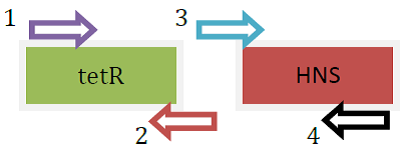From 2011.igem.org
(Difference between revisions)
|
|
| Line 35: |
Line 35: |
| | |} | | |} |
| | </div> | | </div> |
| - | |}
| |
| - | {| style="width:900px;background:#000000;text-align:justify;font-family: georgia, helvetica, arial, sans-serif;color:#ffffff;margin-top:25px;" cellspacing="20"
| |
| - | |-
| |
| - | |style="width:900px;font-size:1.5em;"|''School Workshop''
| |
| - | |-
| |
| - | |style="width:900px;"|
| |
Revision as of 16:55, 4 October 2011
| Lab Diaries
|
| Week 1
Transformation of reporter DNA (pEGFP-loxp-km-loxp) into DH10B (non-virulent strain E. coli) with antibiotic resistance (Chloramphenicol – Cm)
| Lab Diaries
|
Week 2
- tetO2 -1 (DNA binding site)
- Reverse PCR was used to insert tetO2 -1 into pEGFP-loxp-km-loxp (template DNA) by using forward and reverse primers which are with the tetO2 -1. By using reverse PCR, we can insert the tetO2 -1 site into the pEGFP while the plasmid produced is still in double-stranded circular form.
- pEGFP-loxp-km-loxp-tetO2-1 was then transformed into DH10B to greatly amplify the product by using bacterial cells
- tetO2 -2 (DNA biding site)
- Reverse PCR was used to insert tetO2 -2 into pEGFP-loxp-km-loxp
- 2uL of 10-fold diluted pEGFP-loxp-km-loxp- tetO2 -2 was transformed into DH10B to greatly amplify the product by using bacterial cells
- tetO2 – 3 (DNA binding site)
- Reverse PCR was used to insert tetO2 – 3 into pEGFP-loxp-km-loxp
- 2uL of 10-fold diluted pEGFP-loxp-km-loxp- tetO2 – 3 was transformed into DH10B to greatly amplify the product by using bacterial cells
| Lab Diaries
|
Week 3

|
| Fusion protein genes produced separately using PCR
|
|
 "
"



